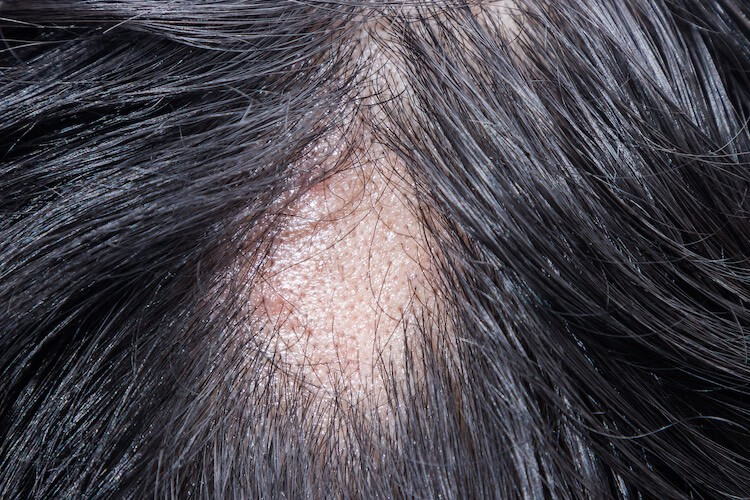You Should Get Patchy Hair Loss Checked Out. Here’s Why.

You’re brushing your teeth, look up, and notice a patchy round bald spot on your head. Wait, that wasn’t there yesterday. Was it? Should I wait a few days and see what happens? Could it get bigger? This can’t be happening. Can I just pretend that it’s not?
Yes, it’s normal to lose some hair each day. And, yes, you may have inherited your Mom, Dad or Grandparent’s hairline. Genetic hair loss happens gradually over time, though. Sudden, excessive, or patchy hair loss is another story. Get to the root cause and find out if treatment options are available. And finally, yes, you should get patchy hair loss checked out by a dermatologist, here’s why:
1. To Rule Out Underlying Medical Conditions
Alopecia areata is a medical condition that occurs when a person’s immune system attacks his or her hair follicles resulting in hair loss. Although alopecia areata is rare, only affecting about two percent of the world’s population (01), patchy hair loss is often a symptom. Hair usually falls out in small, round patches the size of a quarter. Some people experience more extensive hair loss, though. With alopecia areata, you may not have any other symptoms besides hair loss.
Alopecia areata is a non-scarring form of alopecia, meaning that the hair follicles are left intact. Hair may spontaneously regrow. While some people have recurring hair loss, others only have one episode. The condition is unpredictable.
Not all patchy hair loss is due to alopecia areata, though. Patchy hair loss can also be a sign of another autoimmune disease. Lupus and thyroid disease can both cause hair loss. Infections, hairstyles, and hair treatments such as straighteners and perms can also be to blame. Visiting a doctor will help you rule out these causes and any others. Identifying and treating the underlying condition early in the game can help prevent further hair loss.
2. Diagnosing Hair Loss Isn’t as Simple as It Seems
Distinguishing one type of alopecia from another isn’t something you can do yourself. While androgenetic alopecia, male and female pattern baldness, can be diagnosed by a dermatologist during a visual exam, scarring and other types of alopecia require a closer look with a magnifier called a dermatoscope or a biopsy. Happy Head’s dermatologists can diagnose online, but in some cases may recommend scheduling an in-person appointment. To get a free consultation with a Happy Head board-certified dermatologist, take our quick questionnaire here.
3. Treatments Can Be Customized
Medications and treatments vary based on the cause of your hair loss, so your dermatologist needs to nail down the underlying condition to develop an effective treatment plan. Telogen effluvium, temporary alopecia due to stress, illness, medications, or other causes, doesn’t require any treatment. Hair typically regrows within six months to a year. A different approach is required for alopecia areata. Depending upon the severity, treatments may include steroid injections, JAK inhibitors, which are a new class of medication showing great promise (02), and oral or topical medications such as Minoxidil, Finasteride, or Dutasteride. Just as not every case of hair loss is the same, not every person responds the same to hair loss treatments. It may take some time to determine the right mix of medicines for you.
4. Emotional Support & Guidance
Although seeing bald patches may be new, upsetting, and embarrassing to you, dermatologists see cases like yours regularly. Not only do they know what to do to help you, they know what to say. You don’t have to worry that they will think you’re being an alarmist. Instead, your dermatologist can offer reassurance and help you navigate the psychological aspects of losing your hair. They also may be able to refer you to a support group or other resources to help you deal with the emotional challenges you may be facing. Remember, that you don’t have to do it alone. Hair growth is a journey.
5. Prevent Further Hair Loss
The last thing you want is for your alopecia to progress, so early intervention is key when it comes to patchy hair loss. In some cases, once you’ve lost a certain percentage of hair, it’s more challenging to manage or reverse the effects. Early treatment minimizes long-term damage by keeping the hair follicles viable, preventing further hair loss, and jump-starting the growth process.
If you notice patchy hair loss, it’s not only okay to seek treatment; it’s recommended. A dermatologist can determine whether you have alopecia areata or another form of autoimmune hair loss, offer treatment options, and help you wrap your head around what’s happening.
If you have patchy hair loss, thickening shampoo, conditioner, hair growth supplements, and oral or topical medications such as Minoxidil, Finasteride, Dutasteride, or Spironolactone may complement your treatment plan. Visit us to see the array of products available. Need help making a selection? We have dermatologists licensed to practice in every state who can make recommendations. Simply fill out a brief form with your medical history to get started.
Resources:



